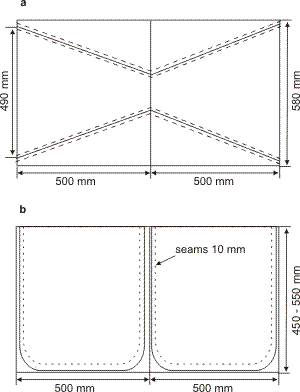7.14.1 Introduction
The biotic composition and biomass of streams react differently to acidification due to different species tolerance (sc. acidification scores). Macroinvertebrates are considered good indicators of acidification and the frequency of acid shocks to streamwater, however universal indicators cannot be identified due to differences in geographical distribution.
7.14.2 Methods
Local circumstances, like depth and bottom consistency, should be taken into consideration when choosing sampling sites. Macrozoobenthos samples are preferably taken from hard bottoms with rapidly running water. An adequate sampling site often covers a stream length of ca. 10 times the width of the stream.
Macrozoobenthos samples are collected twice a year, preferably in spring and autumn. Sampling in spring is done immediately after snow melt, and sampling in autumn should coincide with periods of low flow.
Sample with the kick-sampling method which is suitable for the majority of species living on coarse-grained bottoms and submersed vegetation as well as in fine material between and under stones (sessile species may be underrepresented). Kick-sampling can be performed in waters with velocities of 0.1 - 1 m/s and down to 1 m depth.
Use a sampling net with triangular or square opening (sides 25 cm) and a mesh size of 0.5 mm (Figure 7.14.1). The net and its handle can be cm-graded for recording depth of water. The net should be sterilized between use at different locations to avoid the spreading of possible diseases. This is done by soaking it in formaldehyde or ethanol.
Place the net on the bottom facing streamflow. Turn stones and kick the bottom sediment within an area of 25 x 40 cm2 during 60 seconds. The loose material should pass the net. Take 3 - 6 replicate kick-samples at each site.
Thoroughly rinse every sample and transfer the net residue to a plastic vessel by turning and brushing the net. Pick attached specimens with soft pincers. Transfer the sample to 1 litre jars containing 96 % ethanol.
Transfer the sample in small portions to petridishes and sort them under magnification (e.g. 10 x). Handle the animals with soft pincers. If the determination of species is done afterwards, store the animals according to taxonomic groups and keep the material in air-tight glass capsules in 70 % ethanol. Count the specimens during determination; for fragmented material only identifiable parts are counted. Taxonomic identyfication should be as accurate as possible (species/genus level).
References how to identify to family level are given in references.
Measure the biomass as conserved wet-weight after the animals have been placed in clean water for 10 minutes. When measuring wet weight of preserved material wait for ca. 1 month.
See also Chapter 4 in ICP Waters manual.

Figure 7.14.1 Suggested patterns for nets.
7.14.3 Data reporting
Due to the specific nature of the Macrozoobenthos data, these data are recommended to be stored at the National Focal Points, this is partly due to problems in coding the species and the local expertice needed in evaluation of the data. The assessment of these data will be carried out periodically and a special request will be made for the NFPs prior to the assessment.
The data should cover the characteristics of the sampling site and sampling information, species names with specimen density (ind/m2) and biomass (g/m2), and also the Shannon-Wiener diversity index (for calculation, see Annex 7).
7.14.4 References
ICP Waters Programme manual. Compiled by the the Programme Centre, Norwegian Institute for Water Research. Revised edition, Oslo.
ISO 7828 - 1985
References how to identify the species to family level:
1. A KEY TO THE BRITISH SPECIES OF FRESHWATER CLADOCERA, WITH NOTES ON THEIR ECOLOGY.
D.J. Scourfield & J.P. Harding, Third edition, 1966. (Reprinted 1994)
2. A KEY TO THE BRITISH FRESH- AND BRACKISH-WATER GASTROPODS, WITH NOTES ON THEIR ECOLOGY
T.T. Macan, Fourth edition, 1977. (Reprinted 1994)
3. A KEY TO THE ADULTS AND NYMPHS OF THE BRITISH STONEFLIES (PLECOPTERA), WITH NOTES ON THEIR ECOLOGY AND DISTRIBUTION
H.B.N. Hynes, Third edition, 1977. (Reprinted 1993)
4. A KEY TO THE BRITISH FRESHWATER CYCLOPID AND CALANOID COPEPODS, WITH ECOLOGICAL NOTES
J.P. Harding & W.A. Smith, Second edition, 1974
5. A KEY TO THE BRITISH SPECIES OF FRESHWATER TRICLADS (TURBELLARIA, PALUDICOLA)
T.B. Reynoldson, Second edition, 1978
6. A KEY TO THE LARVAE, PUPAE AND ADULTS OF THE BRITISH DlXIDAE (DlPTERA), THE MENISCUS MIDGES.
R.H.L. Disney. 1975
7. AN ILLUSTRATED KEY TO FRESHWATER AND SOIL AMOEBAE, WITH NOTES ON CULTIVATION AND ECOLOGY.
F.C. Page. 1976
8. A NEW KEY TO FRESHWATER AND SOIL GYMNAMOEBAE, WITH INSTRUCTIONS FOR CULTURE
F.C. Page. 1988
9. A KEY TO THE LARVAE AND ADULTS OF BRITISH FRESHWATER MEGALOPTERA AND NEUROPTERA, WITH NOTES ON THEIR LIFE CYCLES AND ECOLOGY
J.M. Elliott. 1977
10. A KEY TO THE FRESHWATER PLANKTONIC AND SEMI-PLANKTONIC ROTIFERA OF THE BRITISH ISLES.
R.M. Pontin. 1978
11. A KEY TO THE BRITISH AND EUROPEAN FRESHWATER BRYOZOANS.
S.P. Mundy. 1980
12. A KEY TO THE LARVAE OF THE BRITISH ORTHOCLADIINAE (CHIRONOMIDAE).
P.S. Cranston. 1982
13. THE PARASITIC COPEPODA AND BRANCHIURA OF BRITISH FRESHWATER FISHES: A HANDBOOK AND KEY
G. Fryer. 1982
14. EPHEMEROPTERA, WITH NOTES ON THEIR ECOLOGY
J.M. Elliott & U.H. Humpesch. 1983
15. KEYS TO THE ADULTS, MALE HYPOPYGIA, FOURTH-INSTAR LARVAE AND PUPAE OF THE BRITISH MOSQUITOES (CULICIDAE), WITH NOTES ON THEIR ECOLOGY AND MEDICAL IMPORTANCE
P.S. Cranston, C.D. Ramsdale, K.R. Snow & G.B. White. 1987
16. LARVAE OF THE BRITISH EPHEMEROPTERA: A KEY WITH ECOLOGICAL NOTES
J.M. Elliott, U.H. Humpesch & T.T. Macan. 1988
17. ADULTS OF THE BRITISH AQUATIC HEMIPTERA HETEROPTERA: A KEY WITH ECOLOGICAL NOTES
A.A. Savage. 1989
18. A KEY TO THE CASE-BEARING CADDIS LARVAE OF BRITAIN AND IRELAND
I.D. Wallace, B. Wallace & G.N. Philipson. 1990
19. BRITISH FRESHWATER CRUSTACEA MALACOSTRACA: A KEY WITH ECOLOGICAL NOTES
T. Gledhill, D.W. Sutcliffe & W.D. Williams. 1993
20. A REVISED KEY TO THE CASELESS CADDIS LARVAE OF THE BRITISH ISLES, WITH NOTES ON THEIR ECOLOGY
J.M. Edington & A.G. Hildrew. 1995